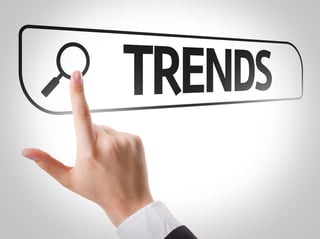Technology influences everything today, even tried-and-true industries like trucking and transportation. The short list of 12 trends briefly covers how tech is changing life on the road as well as in the office.
Platooning
MIT engineers have studied a simple vehicle-platooning scenario and determined the best ways to deploy vehicles in order to save fuel and minimize delays. If performed properly, platooning is expected to raise scheduling efficiency and save up to 20% on fuel costs. Eight states are now onboard with testing the safety and capabilities of platooning. The Competitive Enterprise Institute, a Washington DC lobbying group, is working on assisting legislators in remaining states to revise safety laws currently restricting platooning's adoption. Add to that efforts like partnerships, and platooning might be much closer to becoming reality in the short term. 
Localization
The push toward more localization among transportation service providers appears to be in full swing and will continue to shorten distances between production and consumption. Carriers are exploring the value of regional-based delivery operations which are closer to the end users to reduce costs and enhance efficiency. Localization is quicker, easier and performed at minimal cost. Technology--now faster, stronger and more embedded--is in the equation, helping to facilitate localization. Resulting changes include an increased number of day cabs in operation, power trains running with smaller engines and a strengthening of local economies.
Next Gen Supply Chain
Supply chains are traditionally linear, but today supply chains are transforming into a dynamic, interconnected network, according to an article covering the digital transformation of supply chains, by Deloitte University Press. Transportation service providers are preparing with strategy and innovation to compete in a Next Generation Supply Chain world. Other “must-have” components include velocity in delivery, agility, reach, inventory management and sustainability.
Mobile Apps
Mobile apps improve life in general by providing entertainment, communication and news, but plenty deal with the business side of transportation. Companies are even creating mobile strategies. From parts inventory to maintenance and parking to cross-dock operations, if you can imagine it, there is likely an app for it.
Uber Freight
After upending the taxi industry, Uber is eyeing trucking with Uber Freight, an app that lets truckers find loads and get paid quickly without bounce, factoring or brokers. It’s not a new idea -- similar apps integrate with TMS software-- but Uber has proven it knows how to disrupt a long-standing industry. So far truckers seem wary - the company won’t release download numbers and its slick video advertisement hasn’t drawn many Android users.
Autonomous Electric Trucks
Sweden’s Einride has already unveiled the T-pod prototype, a remote-controlled, autonomous electric truck. According to Venture Beat, in 2020 Einride will begin running 200 vehicles between the coastal cities of Gothenburg and Helsingborg--about two hours apart. Billed as a complete system including charging stations (the vehicles get 124 miles per charge) and an infrastructure, T-pod capacity targets two million pallets per year.
Drop-and-Hook
Drop-and-hook is popular again, especially among smaller fleets. To minimize the impact of shippers that require fleets to pool empty trailers in yards to speed loading, fleets are buying or renting more trailers to achieve faster turnarounds, keep truckers moving and avoid devoting all or most of their fleet to one shipper. The looming ELD mandate also factors into the resurgence as truckers look to minimize wait times.
KPI Dashboards
Once a tool strictly for management, KPI (Key Performance Indicators) Dashboards are now being used by load planners, dispatchers and accounting types, allowing data to be shared and used by multiple users throughout a company. Expanding visibility suggests that staff can monitor as needed and be agile in working to correct problems as they arise. An added bonus: sharing in the pride of hitting goals and other accomplishments.
Cargo Theft
Cargo theft numbers keep rising, especially around all major holidays. A FBI report notes Texas, Tennessee and Florida with the largest number of reported incidents and a total of $32.6 billion in merchandise stolen in all US states in 2014 alone. Parking lots came in as the #1 location of thefts. In part, losses are attributed to unattended and/or unsecured loads. GPS and cargo monitoring services, combined with common sense approaches like using secured yards and a combination of locks, can cut down on losses.
ELD Mandate--Canada
There’s still no hard date set for the release of the final regulations for Canada’s ELD mandate. Omnitrac’s Tom Cuthbertson reports that in April they received new regulations from the Canadian Council of Motor Transport Administrators (CCMTA) for comment. The Keep Truckin blog estimates the final regulations might be published in Q4 of 2017.
Driver Shortage/Retention
Mileage-based pay has kept income for truckers stagnant since the ‘80s despite the driver shortage, but Trucks.com reports that technology such as GPS trackers and telematics could help truck drivers make more money because they provide evidence of how much time it actually takes to deliver a load. Academic research is backing up the need for a new pay model. Read more here.
Congestion
The annual INRIX Global Traffic Scorecard uses data from 1,064 cities in 38 countries to identify the world’s most-congested cities. Top 10 offenders include four in the US with Los Angeles (#1), New York and San Francisco again claiming three of the four top spots. Boston, Washington, DC, Dallas and Chicago rank in the top 20. Montreal and Toronto rank in the top 50.


